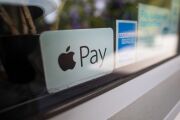Klarna Bank, which advertises itself as a way to spread the cost of the latest brands and smartphones, is shelling out loans for milk and gas with cash-strapped customers looking for ways to cover basic necessities.
Linda Cruz, a mother of four from a small town near San Antonio, Texas, started out using Klarna’s interest-free loans for occasional, large purchases — like a new air conditioning unit after hers died during a heat wave last summer. But as prices started to rise for essentials, she started using it for groceries, too. Cruz, 37, a bail bonds agent and her family’s sole earner, is paid biweekly and said Klarna is a useful budgeting tool, letting her take care of her bills when she gets a paycheck.

“I noticed that I could buy essentials with it, and not have to pay everything up front. And it wouldn’t affect my pocket as much,” Cruz said. “When you break it up into the four payments, it’s biweekly. And I make sure it’s going to fall on the weeks of me getting my paychecks.”
Klarna extends interest-free loans that let consumers spread payments for purchases over multiple installments, instead of all at once. It makes money by charging retailers a small fee on every transaction and from interest on longer-term loans.
The 17-year-old company has embraced the shift in the way people use its credit. Klarna, run by co-founder and Chief Executive Sebastian Siemiatkowski, has struck partnerships with gas companies such as Chevron and developed an app that can be used in physical stores at retailers including Walmart and Target as it hunts for new users. But interest rates for its own debt are rising and Klarna’s burning through hundreds of millions of dollars per quarter, making the company more vulnerable to defaults from customers living paycheck to paycheck.
“This puts pressure on the Klarna model,” said John Colley, a professor of practice in strategy and leadership at the U.K.’s Warwick Business School. As the disposable wealth of the company’s users shrinks, “Klarna will be sat there with substantial bad-debt risks. Their customer base is likely to be subprime anyway.”
Investors have taken note. In a recent funding round, Klarna was only able to command a fraction of the nearly $46 billion valuation it achieved last year, people familiar with the matter have said. The new equity may value the company at as little as $6 billion, they said. Klarna has raised $1.75 billion in funding between 2019 and 2021 in three major funding rounds, the most recent a $639 million round that valued it at $45.6 billion.
The drop tracks with a meltdown in capital markets that’s shaved the valuations of public and private companies alike. But Klarna is particularly vulnerable because higher interest rates, aimed at curbing inflation, boost its own borrowing costs. The prospect of a recession also means consumers will have a harder time paying back their debts.
In a recent study looking at the buy now/pay later industry in the U.K., Barclays and the debt charity StepChange found that 36% of users say this form of lending has become
“The risk that you are building up is a debt problem that could be exacerbated by the cost-of-living crisis,” StepChange representative Sue Anderson said. The charity has seen an increase in clients with buy now/pay later services as part of their outstanding credit.
“People don’t see it in the same way they see other types of borrowing,” Anderson said. “It is marketed as interest free, but that doesn’t mean it is risk free.”
Klarna is a “sustainable alternative” for American consumers who are used to credit card companies with fees and high interest, a company spokesperson said. “If for decades it made sense to use a credit card to pay for groceries, we believe it’s better value for people to use Klarna’s interest-free products.”
The company had also complained about the StepChange survey, saying that Barclays offers an installment credit product with a
Defaults are included in Klarna’s net credit losses, which rose to 1.19 billion Swedish kroner ($110 million) in the first quarter of 2022, up about 50% from the same period the previous year. Meanwhile, the platform is burning through cash, losing more than 7 billion kroner in the quarter.
A spokesperson said that absolute credit losses are higher year over year because of a surge in new users following an expansion in 2021. Credit losses as a proportion of the total customers spend with its service have declined.
While Klarna doesn’t disclose its default rate, the company evaluates customers’ ability to repay on every transaction and losses are consistently less than 1%, a spokesperson said.
Klarna’s cost of borrowing in the open market has risen sharply in the first half of 2022. A February 2024 floating-rate bond has seen Klarna’s discount margin, a measure of the credit spread over benchmark borrowing rates, climb to 318 basis points. That pushed the company’s two-year borrowing cost above 4%, more than double what it was at the start of the year.
Still, for customers like Darrin Givens, a musician and producer from Detroit, Klarna has become an important tool for both discretionary spending and essentials.
“I used Klarna for gas on a trip back home before I made my move from Mississippi to Michigan,” the 32-year-old father of two said. “I stopped at a Chevron and saw that they did Klarna in store and did it through the app. It was fairly easy, and I would do it again.”
— With assistance from Aisha S Gani.






